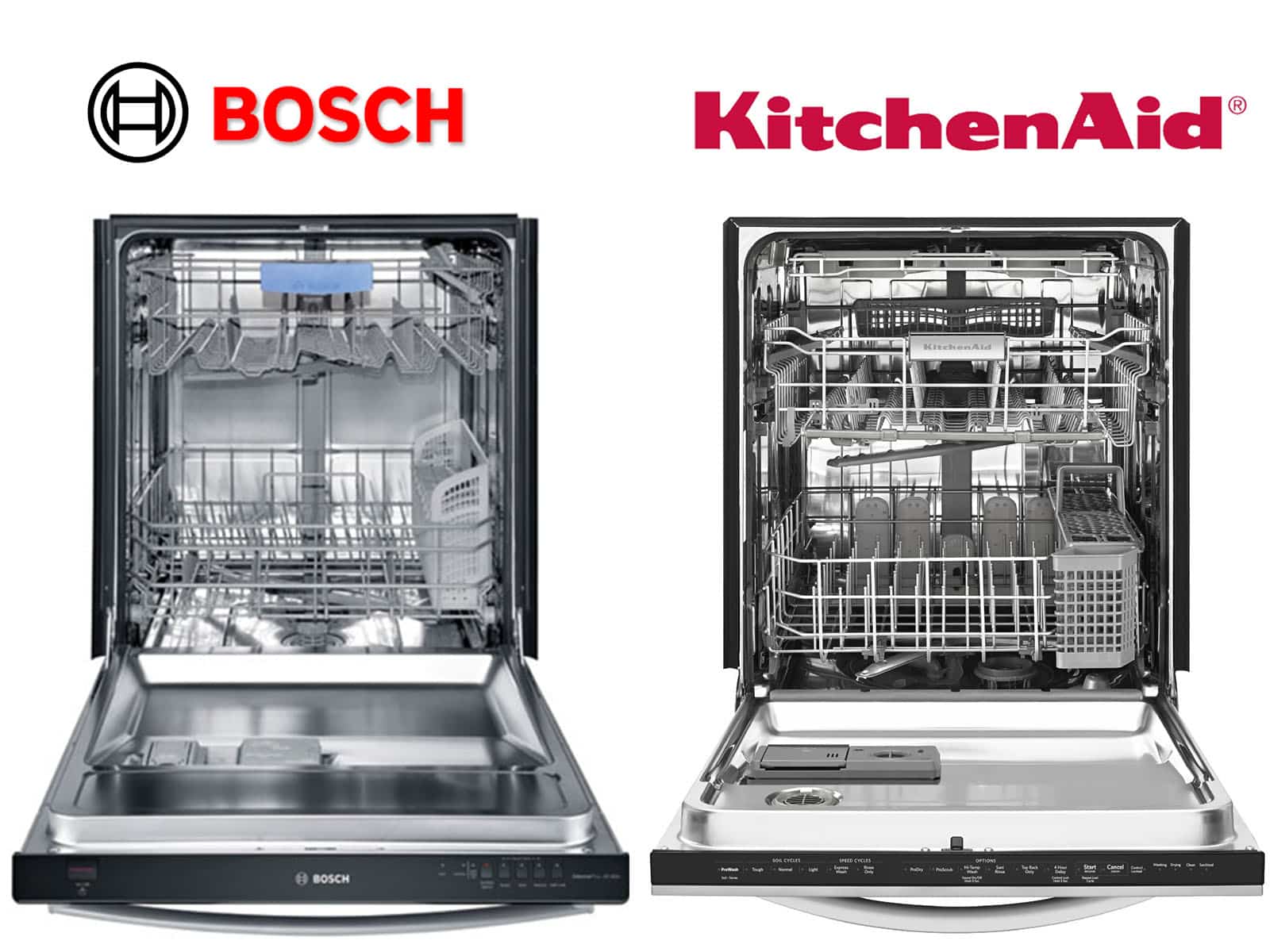
When we compare Kitchenaid dishwashers to Bosch dishwashers it is like comparing a Fuji apple to a McIntosh apple. Both apples are great for baking an apple pie, but is one better than the other? KitchenAid and Bosch are so similar in size, features, performance, and price that it is difficult to pick one above the other. It then becomes a matter of personal preference.
Does size matter?
The size of the dishwasher is dependent upon the space available. Dishwashers come in two basic sizes. The standard size is 24 inches of width and the compact models are generally around 18 inches. If the KitchenAid and the Bosch dishwasher were sitting side by side, they might appear identical in height, width, and depth. But appearances can be deceptive. What consumers want to know is how many dishes will it wash. Most dishwashers come equipped with two racks to place dishes in but the better and generally more expensive models come with three. A full-size dishwasher should hold between 10-15 place settings with 12 being average. A full-size dishwasher will support a family of two adults and two children. That is more than enough room for an entire day of dirty plates, glasses, coffee cups and various utensils. The KitchenAid KDTM354ESS is a large two rack machine which provides space for 15 place settings while the Bosch 500 series features racks that accommodate 16 place settings with a third rack to hold extra utensils and cutlery.
What about features?
When discussing features, one of the things consumers inquire about is the noise level. The KitchenAid and Bosch operate at a quiet 44 decibels. So quiet you could run the dishwasher in a library without disturbing anyone’s reading. The Bosch and the KitchenAid conceal a touch button control panel on top which offer each dishwasher a nice clean appearance. The buttons are kept away from inadvertent hip bumps and unintended use. The interior tub of a Bosch contains more space than the competing KitchenAid, and that means fewer loads and more clean dishes. Both models feature adjustable positions within each rack. For example, adjustable tines in the lower rack of the KitchenAid allow for more space to place pots, pans, and various sized casserole dishes. The upper rack on the Bosch gives way to 3 customizable height adjustments with up to 9 possible rack positions.
Heated Dry vs Condensation Dryer: Bosch does not have a cal-rod element at the bottom of the dishwasher to assist in the drying process. This causes dry times to take a little longer, especially with plastic items. But with no heating element at the bottom of the dishwasher, a customer can place plastic items anywhere and know that there is little chance of the item warping or melting.
Performance comparisons
What everyone wants to know is does the dishwasher clean the dishes? Is washing dishes with a dishwasher better than washing dishes by hand? We think so and want to share a couple of reasons why. According to the Energy Star website, “hand washing your dishes costs on average $431 more in energy and water than using an Energy Star qualified dishwasher.” On average, you could save up to 5,200 gallons of water a year using either brand. Energy Star certified dishwashers have a mechanism that improves water temperature to 140 degrees and some models up to 160 degrees thereby creating an environment for better sanitation when compared to washing dishes by hand. Pre-rinse and scrubbing are things of the past with the KitchenAid and Bosch machines. The KitchenAid dishwasher includes 40 spray jets that continually remove food particles sending them to an eviscerator which chops up food particles sending them down the drain. The Bosch features 5 wash cycles and utilizes a triple filtration system designed to catch food particles. Both models are constructed of stainless steel which provides ideal heat dispersal for ideal drying conditions.
Does price matter?
The KitchenAid and Bosch dishwashers are the two most popular brands on the market today. Price ranges from $360 all the way up to $2,000. The Bosch 500 series will run around $800 and the KitchenAid KDTM354ESS closer to $900. The KitchenAid accommodates fewer dishes for more money but the no fuss filter system and the adjustable fold down tines make this model a great buy. If you are looking for an effective, efficient dishwasher, the Bosch, with its 3rd rack and reputable engineering make the 500 series as desirable as the KitchenAid.
The information provided in this article does not claim to be inclusive of every benefit consumers are looking for in a dishwasher. Provided here are a few details about two of the most reliable and popular dishwashers on the market today. We recommend contacting your local appliance dealer if you have more questions in regards to the differences between these two brands.

How to Fix the nF Error Code on a Samsung Washer

Kenmore Elite Dryer Issues: How To Troubleshoot

Microwave vs. Oven: Pros and Cons and How They Differ

Self-Cleaning Oven Smell: Causes & Odor Reduction Tips

Frigidaire Ice Maker Not Working? 7 Ways to Fix It

Why Is Your LG Refrigerator Not Cooling? (9 Common Reasons)

GE Oven F2 Error: Causes & Solutions

How to Reset the Water Filter Light on a Samsung Refrigerator

Maytag Washer Showing F5 Error Code? Here’s What To Do






